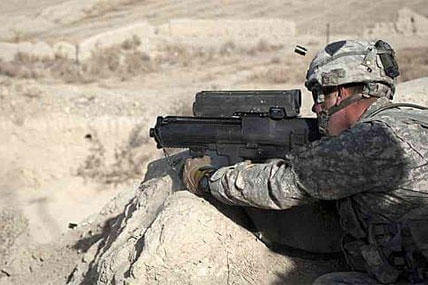The U.S. Army has halted operational testing of its shoulder-fired, 25mm airburst weapon after a soldier suffered minor injuries when the weapon "malfunctioned" in Afghanistan.
"An XM25 experienced a double feed and an unintentional primer ignition of one round," Army spokesman Matt Bourke stated in a March 7 written release, describing the Feb. 2 incident. "The Army subsequently removed all XM25 prototype weapons and ammunition from theater for root cause analysis and corrective action."
The XM25 Counter-Defilade Target Engagement System has already completed one 14-month battlefield assessment and was in the early stages of a second assessment when the double feed and primer ignition occurred during a live-fire training exercise.
"The round involved was a 25mm high-explosive air burst round, though the warhead did not detonate because of safety mechanisms," Bourke said. "The gunner training on the weapon system received superficial injuries, was medically evaluated, and returned to duty."
The XM25, which some troops call the Punisher, has created both excitement and skepticism in the infantry community.
The weapon features a target acquisition system that calculates the target range with a push of a button, and transfers the data to the electronic fuse built into the 25mm round. When fired, the projectile is designed to explode directly above targets out to 600 meters, peppering enemy fighters with shrapnel.
Despite its boxy shape, infantrymen who have fired the XM25 in combat say it's effective at engaging enemy forces hiding behind the short mud walls commonplace across Afghanistan.
But the XM25 has also received its share of criticism from door-kickers who say the five-shot, 14-pound weapon system is more of a burden than a benefit to combat units. In March, elements of 75th Ranger Regiment refused to take XM25 with them for a raid on a fortified enemy compound in Afghanistan, sources familiar with the incident said.
After an initial assessment, Ranger units found the XM25 too heavy and cumbersome for the battlefield. They were also concerned that the limited basic load of 25mm rounds was not enough to justify taking an M4A1 carbine out of the mission, sources say.
XM25 is an offshoot of the Objective Individual Combat Weapon program the Army began in the mid-1990s to increase firepower effectiveness. It was then known as the XM29 -- an over-and-under system with a 5.56mm carbine on the bottom and the 20mm airburst weapon on top.
The XM29 suffered its own range mishap Sept 29, 1999 when a prototype blew up at Aberdeen Proving Ground, MD., spewing shrapnel in all directions and injuring two technicians.
The OICW program stalled in the face of technical challenges that made the 18-pound weapon too heavy and bulky. The program ended up costing about $100 million.
The XM25, however, will continue through its "Engineering, Manufacture & Development" phase where the system will be further refined and improved, Army officials say. It's unclear how this latest mishap will affect program officials' plans to begin fielding the XM25 in the fall of 2014.





























